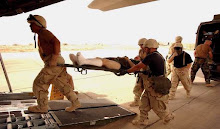Friday, August 14, 2009
Healthy, safe living should be part of national discussion
By Steve Hammons
America, heal thyself.
As debates about
personal, family, community and national health continue, there have been
limited discussions regarding physical fitness, healthy living, safety
education and personal responsibility.
For example, the
challenge of overweight and obese adults, teens and children in the U.S.
appears to be just one of many areas where low-cost or no-cost solutions are
within reach. Heart disease, diabetes and a multitude of other health problems
are linked to the overweight and obesity epidemic in the U.S.
And while many Americans
have begun physical exercise activities, changed their eating habits and
improved their physical fitness, millions still have not.
The overweight and
obesity dilemma, though ultimately linked to personal behavior, also ties in
with family and community attitudes and support systems.
Similar factors can be
seen regarding tobacco smoking and unsafe behaviors that lead to different
types of health problems and accident injuries.
FELLOWSHIP OF THE GYM
Behavior, healthy or
unhealthy, flows from within. Attitudes, motivation, personal history,
self-image, personality and other elements can play large parts in
health-related action or inaction.
Knowledge and
information about healthy living are also key. Support systems of friends,
family or other associates can also be important factors.
When it comes to
physical fitness, many people find that participation at a gym, fitness club,
community center, YMCA, Boys & Girls Club or other facility helps them
get and stay motivated to exercise and continually improve their fitness
levels.
Being around other
people who are participating in health and fitness activities can be helpful.
At today’s fitness centers, all ages of people can be seen on the treadmill or
work-out machines. Young and middle-aged adults, grandparents and teens are
often exercising together.
Some people say that
this environment of common purpose – exercising and getting or staying in shape
– can contribute to a unique sort of fellowship and mutual support. Finding a
work-out buddy or buddies can also provide motivation and make exercising more
fun. These buddies can be friends or family, co-workers or teammates.
If a formal facility is
not available, there are many other options such as walking, stretching, jogging, hiking, bike riding or lifting weights with simple dumbbells (no, we’re not referring
to your work-out buddies). Various other kinds of exercise and sports
activities also can be fun and motivating.
In addition, some
research indicates that moderate and vigorous exercise can help relieve stress,
improve sleep, decrease anxieties and improve mood.
And then there is the
personal satisfaction to be gained by setting a goal and doing your best to
work toward that goal. When it comes to health and fitness, this can be
particularly rewarding.
HEALTHY AND SAFE
Many of the same factors
that apply to physical exercise and fitness are also in play regarding tobacco
use, unhealthy eating and unsafe behaviors that can contribute to ill-health or
accident injuries.
Ceasing tobacco use can
be accomplished, though it reportedly is difficult. Certain aids such as
nicotine gum and patches are available to make success more likely.
Healthier eating is not
rocket science. Less junk food, more fruits and vegetables. Lean meats
including chicken and fish. Smaller portions. Some people suggest smaller
meals, but more frequent meals every couple of hours or so. There are plenty of
healthy eating ideas out there that seem to make sense.
When we look at accident
injuries, sometimes we find that risky behaviors caused or contributed to the
injury. On the other hand, sometimes the causes are situations and risks that
are a natural part of life, such as playing sports or simply getting out of
your shower and slipping on a wet floor.
However, by increasing
safety education and awareness, many accidents can be prevented.
For example, falls are a
primary cause of injuries to children, including serious injuries that require
treatment at a hospital emergency department or trauma center. Although
children will always take spills, many serious falls are probably preventable
by common-sense adult supervision and educating children about the dangers of
certain behaviors.
Families, schools,
neighborhoods and communities have many options to teach kids about things like
falls, bicycle safety, crossing busy streets and similar basic safety
education. Local fire and police departments often provide personnel to visit
schools and provide these kinds of orientations for kids.
The list goes on and on
about the dozens of steps that can be taken to improve the health and safety of
all Americans. Most of them only require common sense and a determination to do
what is needed to get and stay healthy and safe.



































































































































































































